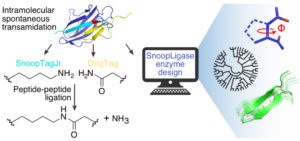SnoopLigase for catalysis of ligation between two peptide tags

To enhance current bioconjugation technology, Oxford researchers have developed SnoopLigase, a catalyst for the formation of a covalent link between two peptides – SnoopTag and DogTag. This technology addresses the limitation of the widely used Oxford ‘bacterial superglue’ technology – SpyTag/SpyCatcher system – which is mainly caused by the size of the Catcher – the protein partner of the Tag peptide.
The invention maximises the potential of the Tag/Catcher system and renders experimental design and the usage of the system more flexible. By using SnoopLigase in combination with the SpyTag/SpyCatcher system, researchers can construct biomaterials and enhance enzyme stability, in addition to the diverse uses of the powerful SpyTag/SpyCatcher system, which include tagging biophysical probes to specific proteins, conjugating antigens to virus-like particles for vaccination, and linking multiple enzymes into pathways to promote metabolic efficiency.
Tag/Catcher systems
SpyTag/SpyCatcher and SnoopTag/SnoopCatcher are powerful bioconjugation tools developed by Oxford researchers by exploiting the natural properties of Streptococcus pyogenes and S. pneumoniae. The Tags and Catchers act as ‘superglue’ for proteins – spontaneously forming irreversible isopeptide bonds with each other when combined.
The Tag/Catcher technologies are currently used by researchers worldwide. The functionality of the tools is, however, limited by the size of the Catcher – the partner protein for the corresponding Tag peptide. For example, the Catchers need to be fused at the termini of proteins to prevent protein folding interferences. Moreover, when the Tag/Catcher systems are used for vaccine optimisation, the induction of antibodies or T cells may be directed towards the Catcher rather than the target antigen.
SnoopLigase
The same Oxford research group have solved the problem by developing SnoopLigase. SnoopLigase catalyses the irreversible conjugation between SnoopTag and a novel peptide (known as DogTag). The functionality of SnoopLigase is much better than its predecessor, SpyLigase, with the following improvements:
- Coupling efficiency is much higher (95% vs. 50%)
- The speed of reaction is increased by 6-fold (4 hours vs. 24 hours)
- Works at 25°C and 37°C (while SpyLigase only works at 4°C)
- Works across a broader range of buffers
This invention maximises the potential of the Tag/Catcher system and provides a great deal of flexibility to experimental design and uses. For instance, SnoopLigase can be used for biomaterial construction and conferred exceptional heat resilience when cyclising different enzymes, on top of all the applications of the Tag/Catcher system including:
•Fluorescent or biophysical probe tagging of specific proteins
•Protein immobilisation for proteomics
•Linking multiple enzymes into pathways to promote metabolic efficiency.
Commercialisation
This technology is subject to patent application. Oxford University Innovation would like to speak to companies who are interested in licensing this technology.
about this technology

